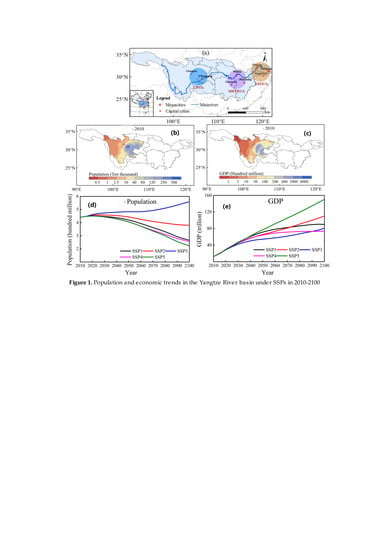Population and Economic Projections in the Yangtze River Basin Based on Shared Socioeconomic Pathways
Abstract
1. Introduction
2. Materials and Methods
2.1. Study Area
2.2. Data
2.3. Methods
3. Results
3.1. Verification of Prediction Results
3.2. The Population and Economic Situation of the Yangtze River Basin before the 2050s
3.3. Population and Economic Trends for 2010–2100
3.4. Population and Economic Changes of Three Major Urban Agglomerations in Yangtze River Basin
3.5. Per Capita GDP in Yangtze River Basin from 2010 to 2100
4. Discussion
5. Conclusions
- (1)
- The population of the Yangtze River basin shows a negative growth during the period of 2021–2050. It is mainly concentrated in Sichuan Province, Chongqing City, Hubei Province, Hunan Province and Anhui Province. The Eastern Sichuan Province will see the most significant population decrease, and Shanghai the most significant population increase. The GDP will continue to increase in most of the Yangtze River basin, and it will increase by CNY 30 billion compared to 2010 in most regions.
- (2)
- During the period of 2010–2100, the population shows a declining trend except for the SSP3 scenario in the Yangtze River basin. The peak population of each path will be 452 million (2022), 460 million (2026), 559 million (2100), 451 million (2021), and 451 million (2020). By the end of the 21st century, the GDP of different paths in the Yangtze River basin will be 7.33, 8.94, 6.55, 5.98, and 12.21 times in 2010, respectively.
- (3)
- As a whole, the population of the three major urban agglomerations will decrease in the 21st century. The negative population growth rate for the CYUA and MYRUA will appear in 2020, while it will occur in the 2030s–2040s for the YRDUA. However, the GDP growth rate shows a downward trend and the decline rate will gradually slow down after 2050.
- (4)
- The per capita GDP growth rate shows a downward trend after 2020. The growth rate of per capita GDP will be about 1% under the SSP2, SSP3 and SSP4 scenarios by 2100, and it will be that of about 0.55% and 2.32% under the SSP1 and SSP5 scenarios, respectively. The per capita GDP in the upper-middle reaches of the Yangtze River basin will increase by about CNY 40,000 to 70,000 compared with 2010, while the per capita GDP in the lower reaches will increase by CNY 80,000 to 110,000 during the period of 2021–2050 under different scenarios.
Author Contributions
Funding
Acknowledgments
Conflicts of Interest
References
- Moss, R.H.; Edmonds, J.A.; Hibbard, K.A.; Manning, M.R.; Rose, S.K.; van Vuuren, D.P.; Carter, T.R.; Emori, S.; Kainuma, M.; Kram, T.; et al. The next generation of scenarios for climate change research and assessment. Nature 2010, 463, 747–756. [Google Scholar] [CrossRef]
- Muller, R.A.; Rohde, R.; Jacobsen, R.; Muller, E.; Wickham, C. A New Estimate of the Average Earth Surface Land Temperature Spanning 1753 to 2011. Geoinform. Geostat. Overv. 2013, 1, 1–7. [Google Scholar] [CrossRef]
- Trenberth, K.E.; Fasullo, J.T.; Shepherd, T.G. Attribution of climate extreme events. Nat. Clim. Chang. 2015, 5, 725–730. [Google Scholar] [CrossRef]
- Riahi, K.; van Vuuren, D.P.; Kriegler, E.; Edmonds, J.; O’Neill, B.C.; Fujimori, S.; Bauer, N.; Calvin, K.; Dellink, R.; Fricko, O.; et al. The Shared Socioeconomic Pathways and their energy, land use, and greenhouse gas emissions implications: An overview. Glob. Environ. Chang. 2017, 42, 153–168. [Google Scholar] [CrossRef]
- Kriegler, E.; O’Neill, B.C.; Hallegatte, S.; Kram, T.; Lempert, R.J.; Moss, R.H.; Wilbanks, T. The need for and use of socio-economic scenarios for climate change analysis: A new approach based on shared socio-economic pathways. Glob. Environ. Chang. 2012, 22, 807–822. [Google Scholar] [CrossRef]
- Kriegler, E.; Edmonds, J.; Hallegatte, S.; Ebi, K.L.; Kram, T.; Riahi, K.; Winkler, H.; van Vuuren, D.P. A new scenario framework for climate change research: The concept of shared climate policy assumptions. Clim. Chang. 2014, 122, 401–414. [Google Scholar] [CrossRef]
- Bashford, A. Global population: History, geopolitics, and life on earth. Glob. Public. Health 2014, 10, 129–131. [Google Scholar]
- Taylor, K.E.; Stouffer, R.J.; Meehl, G.A. An Overview of CMIP5 and the Experiment Design. B Am. Meteorol. Soc. 2012, 93, 485–498. [Google Scholar] [CrossRef]
- van Vuuren, D.P.; Riahi, K.; Moss, R.; Edmonds, J.; Thomson, A.; Nakicenovic, N.; Kram, T.; Berkhout, F.; Swart, R.; Janetos, A.; et al. A proposal for a new scenario framework to support research and assessment in different climate research communities. Glob. Environ. Chang. 2012, 22, 21–35. [Google Scholar] [CrossRef]
- Huang, J.; Wang, Y.; Fischer, T.; Su, B.; Li, X.; Jiang, T. Simulation and projection of climatic changes in the Indus River Basin, using the regional climate model COSMO-CLM. Int. J. Climatol. 2017, 37, 2545–2562. [Google Scholar] [CrossRef]
- Su, B.; Huang, J.; Gemmer, M.; Jian, D.; Tao, H.; Jiang, T.; Zhao, C. Statistical downscaling of CMIP5 multi-model ensemble for projected changes of climate in the Indus River Basin. Atmos. Res. 2016, 178, 138–149. [Google Scholar] [CrossRef]
- O’Neill, B.C.; Kriegler, E.; Ebi, K.L.; Kemp-Benedict, E.; Riahi, K.; Rothman, D.S.; van Ruijven, B.J.; van Vuuren, D.P.; Birkmann, J.; Kok, K.; et al. The roads ahead: Narratives for shared socioeconomic pathways describing world futures in the 21st century. Glob. Environ. Chang. 2017, 42, 169–180. [Google Scholar] [CrossRef]
- Nakicenovic, N.; Lempert, R.J.; Janetos, A.C. A Framework for the Development of New Socio-economic Scenarios for Climate Change Research: Introductory Essay. Clim. Chang. 2014, 122, 351–361. [Google Scholar] [CrossRef]
- Arnell, N.W.; Arnell, N.W.; Lloyd-Hughes, B.; Lloyd-Hughes, B. The global-scale impacts of climate change on water resources and flooding under new climate and socio-economic scenarios. Clim. Chang. 2014, 122, 127–140. [Google Scholar] [CrossRef]
- Popp, A.; Calvin, K.; Fujimori, S.; Havlik, P.; Humpenöder, F.; Stehfest, E.; Bodirsky, B.L.; Dietrich, J.P.; Doelmann, J.C.; Gusti, M.; et al. Land-use futures in the shared socio-economic pathways. Glob. Environ. Chang. 2017, 42, 331–345. [Google Scholar] [CrossRef]
- Dellink, R.; Chateau, J.; Lanzi, E.; Magné, B. Long-term economic growth projections in the Shared Socioeconomic Pathways. Glob. Environ. Chang. 2017, 42, 200–214. [Google Scholar] [CrossRef]
- Weng, Y.; Cai, W.; Wang, C. The application and future directions of the Shared Socioeconomic Pathways (SSPs). Clim. Chang. Res. 2020, 16, 215–222. [Google Scholar]
- Neill, B.C.; Tebaldi, C.; van Vuuren, D.P.; Eyring, V.; Friedlingstein, P.; Hurtt, G.; Knutti, R.; Kriegler, E.; Lamarque, J.; Lowe, J.; et al. The Scenario Model Intercomparison Project (ScenarioMIP) for CMIP6. Geosci. Model. Dev. 2016, 9, 3461–3482. [Google Scholar] [CrossRef]
- Eyring, V.; Bony, S.; Meehl, G.A.; Senior, C.A.; Stevens, B.; Stouffer, R.J.; Taylor, K.E. Overview of the Coupled Model Intercomparison Project Phase 6 (CMIP6) experimental design and organization. Geosci. Model. Dev. 2016, 9, 1937–1958. [Google Scholar] [CrossRef]
- Gidden, M.J.; Riahi, K.; Smith, S.J.; Fujimori, S.; Luderer, G.; Kriegler, E.; van Vuuren, D.P.; van den Berg, M.; Feng, L.; Klein, D.; et al. Global emissions pathways under different socioeconomic scenarios for use in CMIP6: A dataset of harmonized emissions trajectories through the end of the century. Geosci. Model. Dev. 2019, 12, 1443–1475. [Google Scholar] [CrossRef]
- Warszawski, L.; Frieler, K.; Huber, V.; Piontek, F.; Serdeczny, O.; Schewe, J. The Inter-Sectoral Impact Model Intercomparison Project (ISI–MIP): Project framework. Proc. Natl. Acad. Sci. USA 2014, 111, 3228–3232. [Google Scholar] [CrossRef] [PubMed]
- Chen, Y.; Guo, F.; Wang, J.; Cai, W.; Wang, C.; Wang, K. Provincial and gridded population projection for China under shared socioeconomic pathways from 2010 to 2100. Sci. Data 2020, 7, 83. [Google Scholar] [CrossRef] [PubMed]
- Pan, J.; Su, B.; Zhai, J.; Wang, Y.; Jiang, T. Development of economy and its influencing factors in China under the shared socioeconomic pathways. Adv. Clim. Chang. Res. 2019, 15, 607–616. [Google Scholar]
- Huang, J.; Qin, D.; Jiang, T.; Wang, Y.; Feng, Z.; Zhai, J.; Cao, L.; Chao, Q.; Xu, X.; Wang, G.; et al. Effect of Fertility Policy Changes on the Population Structure and Economy of China: From the Perspective of the Shared Socioeconomic Pathways. Earth’s Future 2019, 7, 250–265. [Google Scholar] [CrossRef]
- KC, S.; Lutz, W. Demographic scenarios by age, sex and education corresponding to the SSP narratives. Popul. Environ. 2014, 35, 243–260. [Google Scholar] [CrossRef]
- Leimbach, M.; Kriegler, E.; Roming, N.; Schwanitz, J. Future growth patterns of world regions—A GDP scenario approach. Glob. Environ. Chang. 2015, 42, 215–225. [Google Scholar] [CrossRef]
- Schewe, J.; Heinke, J.; Gerten, D.; Haddeland, I.; Arnell, N.W.; Clark, D.B.; Dankers, R.; Eisner, S.; Fekete, B.M.; Colón-González, F.J.; et al. Multimodel assessment of water scarcity under climate change. Proc. Natl. Acad. Sci. USA 2014, 111, 3245–3250. [Google Scholar] [CrossRef]
- Wiebe, K.; Lotze-Campen, H.; Sands, R.; Tabeau, A.A.; Meijl, V.J.C.M. Climate change impacts on agriculture in 2050 under a range of plausible socioeconomic and emissions scenarios. Environ. Res. Lett. 2015, 10, 85010. [Google Scholar] [CrossRef]
- Hanasaki, N.; Fujimori, S.; Yamamoto, T.; Yoshikawa, S.; Masaki, Y.; Hijioka, Y.; Kainuma, M.; Kanamori, Y.; Masui, T.; Takahashi, K.; et al. A global water scarcity assessment under Shared Socio-economic Pathways—Part 1: Water use. Hydrol. Earth Syst. Sci. 2013, 17, 2375–2391. [Google Scholar] [CrossRef]
- Zhu, M. Industry reconstruction and coordinated development of Yangtze River economic zone. In Proceedings of the 2016 International Conference on Logistics, Informatics and Service Sciences (LISS), Sydney, NSW, Australia, 24–27 July 2016; pp. 1–7. [Google Scholar]
- Jiang, T.; Zhao, J.; Jing, C.; Cao, L.; Wang, Y.; Sun, H.; Wang, A.; Huang, J.; Su, B.; Wang, R. National and Provincial Population Projected to 2100 Under the Shared Socioeconomic Pathways in China. Adv. Clim. Chang. Res. 2017, 13, 128–137. [Google Scholar]
- Wang, Y.; Jing, C.; Cao, L.; Zhai, J.; Tao, H.; Gao, C. The Population Patterns over China Under the 1.5 °C and 2.0 °C Warming Targets. Adv. Clim. Chang. Res. 2017, 13, 327–336. [Google Scholar]
- Jiang, T.; Zhao, J.; Cao, L.; Wang, Y.; Su, B.; Jing, C.; Wang, R.; Gao, C. Projection of national and provincial economy under the shared socioeconomic pathways in China. Adv. Clim. Chang. Res. 2018, 14, 50–58. [Google Scholar]
- Ding, X.; Zhong, F.; Mao, J.; Song, X.; Huang, C. Provincial urbanization projected to 2050 under the shared socioeconomic pathways in China. Adv. Clim. Chang. Res. 2018, 14, 392–401. [Google Scholar]
- Xu, Y.; Xu, C.; Gao, X.; Luo, Y. Projected changes in temperature and precipitation extremes over the Yangtze River Basin of China in the 21st century. Quatern. Int. 2009, 208, 44–52. [Google Scholar] [CrossRef]
- Tian, J.; Chang, J.; Zhang, Z.; Wang, Y.; Wu, Y.; Jiang, T. Influence of Three Gorges Dam on Downstream Low Flow. Water-Sui 2019, 11, 65. [Google Scholar] [CrossRef]
- Meng, L.; Li, C.; Hu, G. Predictions of China’s Population Structure Based on the PDF Model. China Popul. Resour. Environ. 2014, 24, 132–141. [Google Scholar]
- McCombie, J.; Thirlwall, A.P. Economic Growth and the Balance-of-Payments Constraint; The Macmillan Press Ltd.: London, UK, 1994; pp. 1–616. [Google Scholar]
- Liu, Y. Using the theory and method of analysis of Cobb-Douglas production function to study regional economy. Areal Res. Dev. 1989, 8, 89–93. [Google Scholar]
- Zakir Hossain, M.; Said Al Amri, K. Use of Cobb-Douglas production model on some selected manufacturing industries in Oman. Educ. Bus. Soc. Contemp. Middle East. Issues 2010, 3, 78–85. [Google Scholar] [CrossRef]
- Biddle, J. Retrospectives: The Introduction of the Cobb–Douglas Regression. J. Econ. Perspect. 2012, 26, 223–236. [Google Scholar] [CrossRef]
- Jiang, T.; Wang, Y.; Yuan, J.; Chen, Y.; Gao, X.; Jing, C.; Wang, G.; Wu, X.; Zhao, C. Projection of population and economy in the Belt and Road countries (2020‒2060). Adv. Clim. Chang. Res. 2018, 14, 155–164. [Google Scholar]
- Wang, J.; Ge, Y. Assessment of 2010 Census Data Quality and Past Population Changes. Popul. Res. 2013, 37, 22–33. [Google Scholar]
- Jiang, L. Internal consistency of demographic assumptions in the shared socioeconomic pathways. Popul. Environ. 2014, 35, 261–285. [Google Scholar] [CrossRef] [PubMed]
- Chen, F.; Liu, G. Population Aging in China; Bangkok Thailand U: Watthana, Bangkok, Thailand, 2009; Volume 1, pp. 157–172. [Google Scholar]
- Peng, X. China’s Demographic History and Future Challenges. Science 2011, 333, 581–587. [Google Scholar] [CrossRef] [PubMed]
- Feng, W.; Cai, Y.; GU, B. Population, Policy, and Politics: How Will History Judge China’s One-Child Policy? Popul. Dev. Rev. 2012, 38, 115–129. [Google Scholar] [CrossRef]
- Zeng, Y.; Hesketh, T. The eff ects of China’s universal two-child policy. Lancet 2016, 388, 1930–1938. [Google Scholar] [CrossRef]
- Zheng, Z.; Yong, C.; Wang, F.; Gu, B. Below-Replacement Fertility and Childbearing Intention in Jiangsu Province, China. Asian Popul. Stud. 2009, 5, 329–347. [Google Scholar]
- Zhang, X.; Huang, C.; Zhang, Q.; Chen, S.; Fan, Q. Fertility Intention for the Second Child under the Selective and Universal Two-Child Policies: Comparisons and Implications. Popul. Res. 2016, 40, 87–97. [Google Scholar]
- Boke-Olén, N.; Abdi, A.M.; Hall, O.; Lehsten, V. High-resolution African population projections from radiative forcing and socio-economic models, 2000 to 2100. Sci. Data 2017, 4, 1–9. [Google Scholar] [CrossRef]
- Fang, J.; Wang, Z.; Zhao, S.; Li, Y.; Tang, Z.; Yu, D.; Ni, L.; Liu, H.; Xie, P.; Da, L.; et al. Biodiversity changes in the lakes of the Central Yangtze. Front. Ecol. Environ. 2006, 4, 369–377. [Google Scholar] [CrossRef]
- Li, H.; Huang, X.; Jin, Y.; Zhang, X. Population Carrying Capacity of Water Resources in the Yangtze River Economic Belt. Econ. Geogr. 2017, 37, 181–186. [Google Scholar]
- Chen, Y.; Zhang, S.; Huang, D.; Li, B.; Liu, J.; Liu, W.; Ma, J.; Wang, F.; Wang, Y.; Wu, S.; et al. The development of China’s Yangtze River Economic Belt: How to make it in a green way? Sci. Bull. 2017, 62, 648–651. [Google Scholar] [CrossRef]
- Ma, J.; Wu, Y.; Deng, X. Green development of industries in Yangtze River Economic Belt. Ecol. Econ. 2016, 12, 287–295. [Google Scholar]
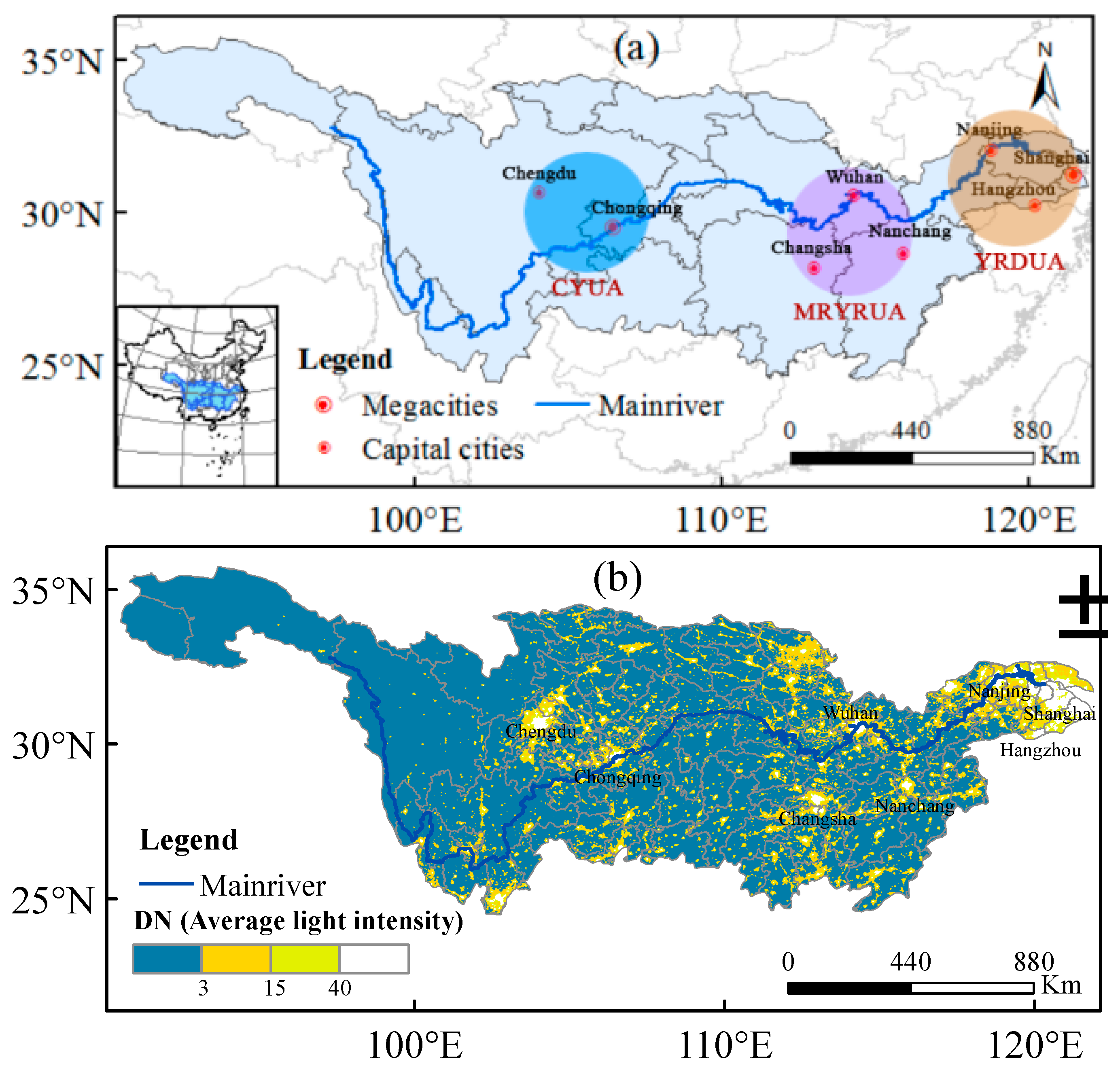


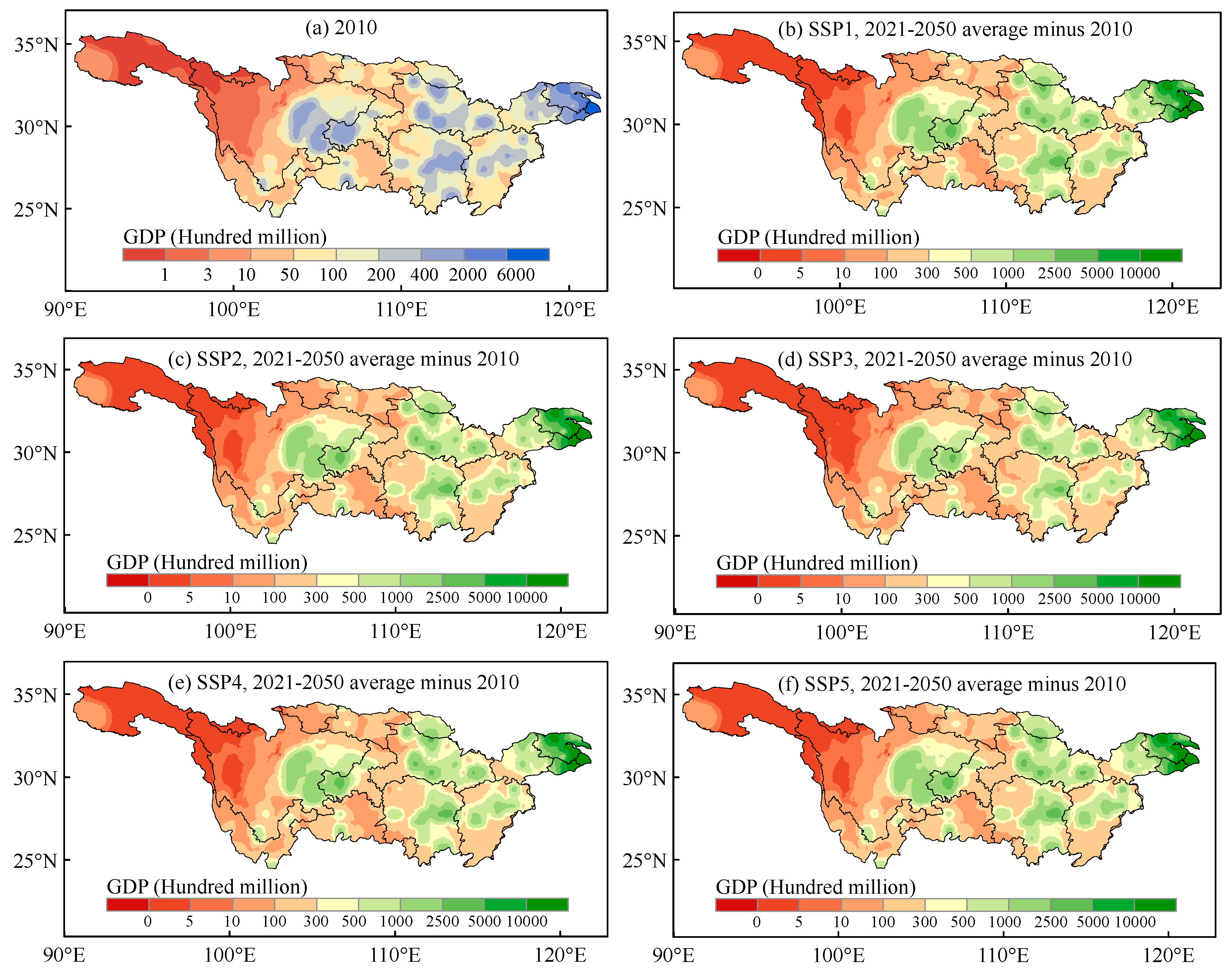

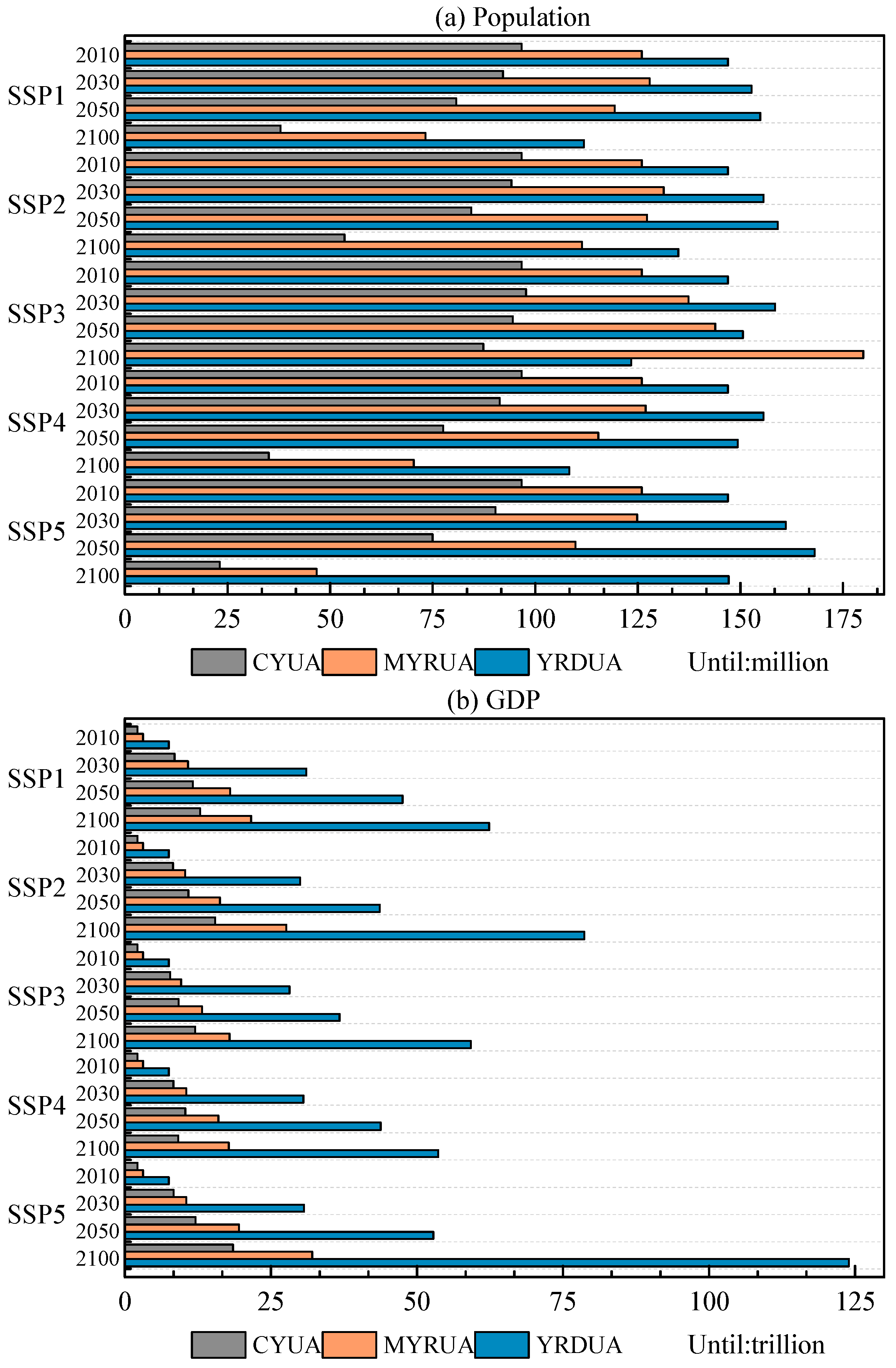
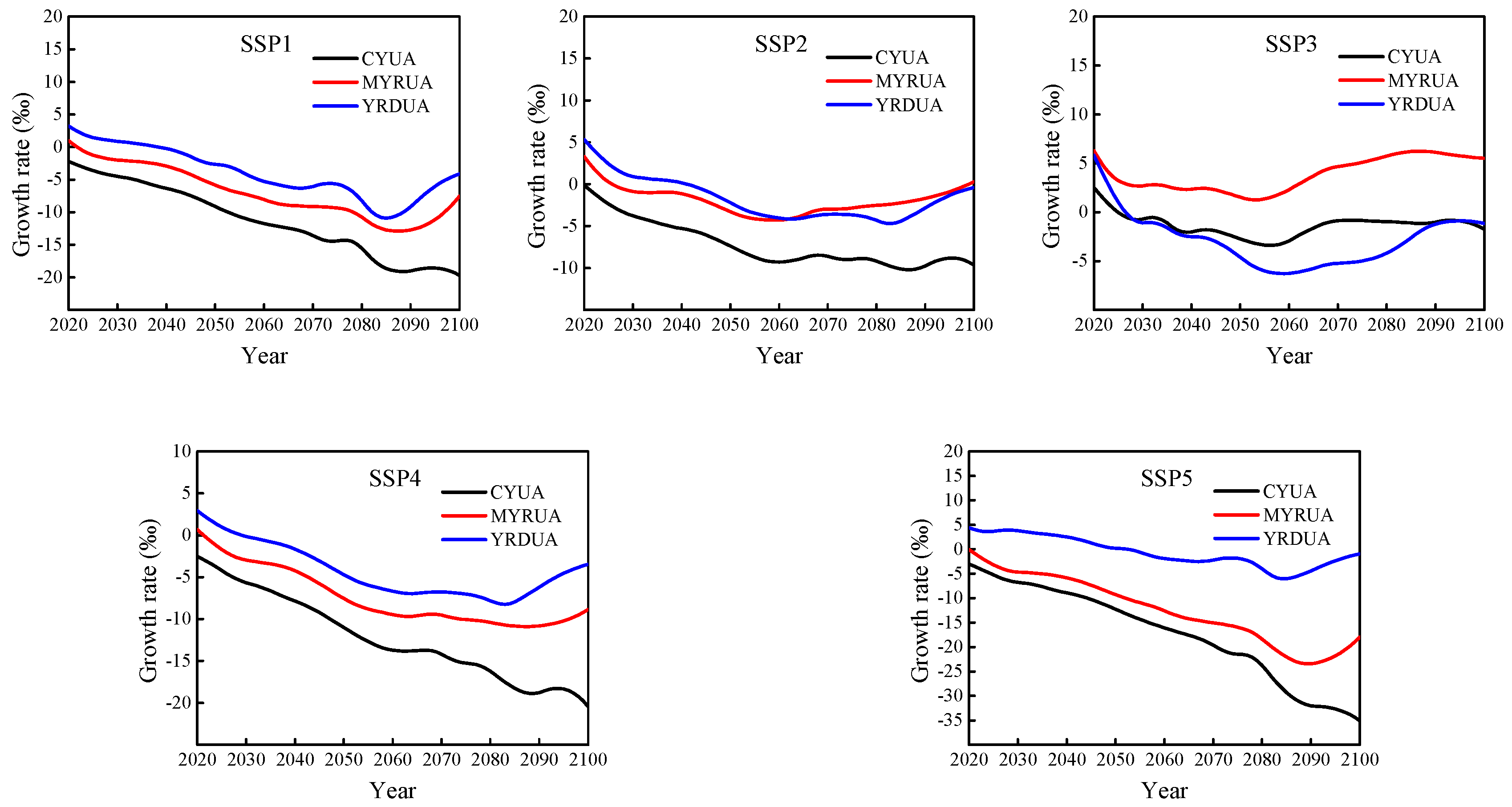
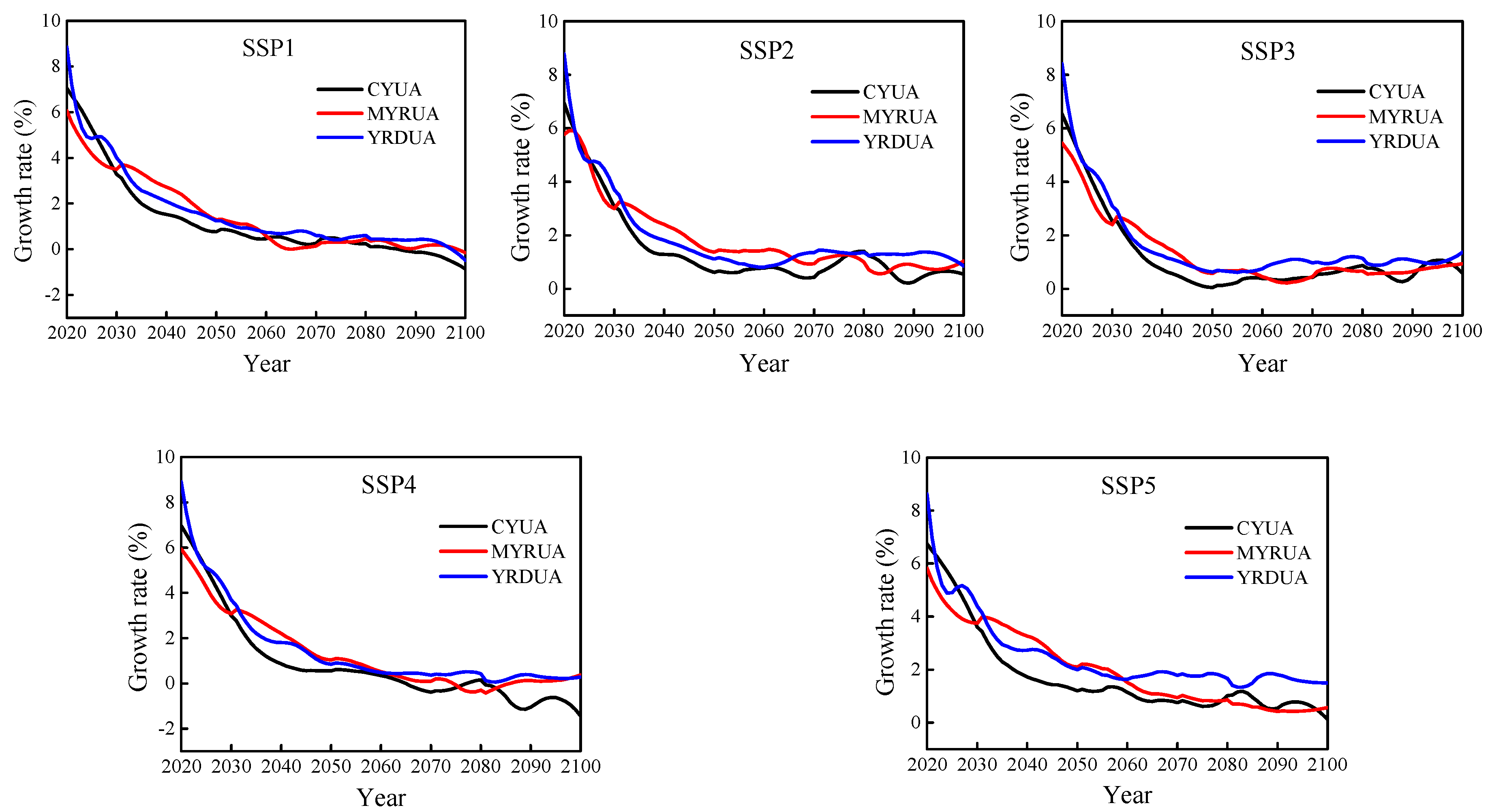
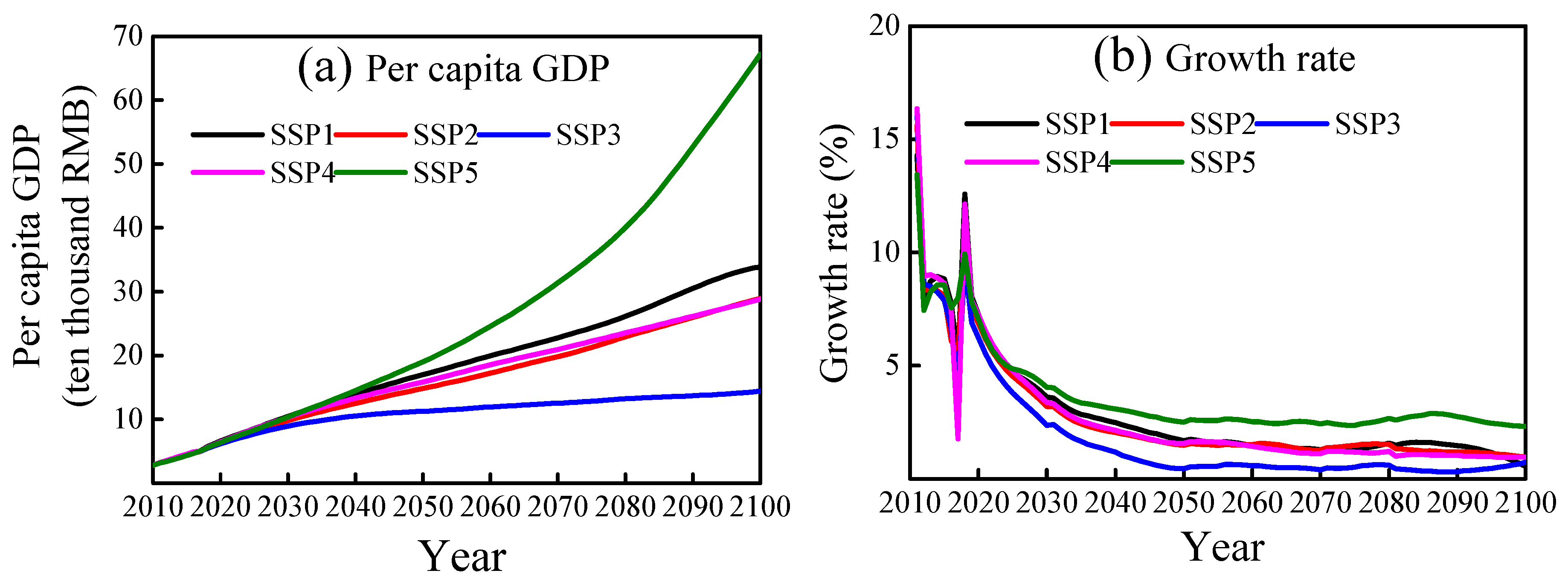
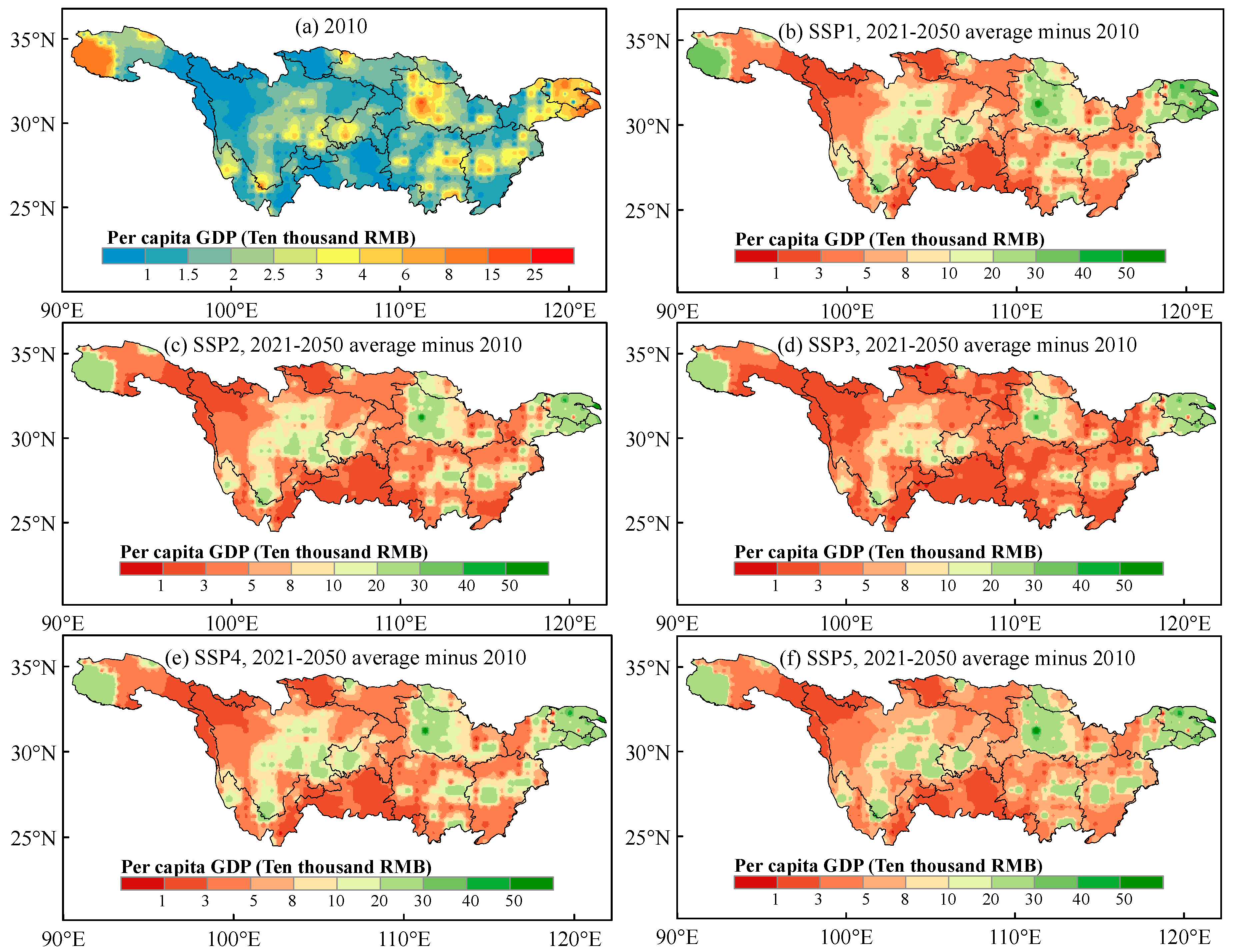
| Urban Agglomeration | Main Cities | Number of Cities | Population (Million) | GDP (Trillion) | |
|---|---|---|---|---|---|
| YRDUA | Yangtze River Delta Urban Agglomeration | Shanghai | 26 | 150 | 12.67 |
| Nanjing | |||||
| Hangzhou | |||||
| Hefei | |||||
| MYRUA | Middle Yangtze Reaches Urban Agglomeration | Wuhan | 31 | 121 | 6.0 |
| Changsha | |||||
| Nanchang | |||||
| CYUA | Chengdu-Chongqing Urban Agglomeration | Chongqing | 16 | 91 | 3.76 |
| Chengdu | |||||
| Model Parameter | Fertility | Mortality | Mobility | Education |
|---|---|---|---|---|
| SSP1 | Low | Low | Medium | High |
| SSP2 | Medium | Medium | Medium | Medium |
| SSP3 | High | High | Low | Low |
| SSP4 | Low | Medium | Medium | Low |
| SSP5 | Low | Low | High | High |
| SSP Narratives | |
|---|---|
| SSP1 | Sustainability—Green development path (Low climate change challenge), low fertility, high life expectancy, moderate migration, high education levels |
| SSP2 | Middle of the Road (Medium climate change challenge) Parameters such as fertility, mortality, migration and education are all medium-sized assumptions |
| SSP3 | Regional Rivalry—A Rocky Road (Climate change challenges are higher) The education level maintains the current enrollment rate, high fertility, high mortality, low migration |
| SSP4 | Inequality—A Road Divided (Focusing on adapting to challenges, mitigation challenges are low) The low fertility countries will have low fertility, medium mortality, medium migration, and low education. |
| SSP5 | Fossil-fueled Development—Taking the Highway (Traditional development scenarios focus on mitigating challenges) low fertility and mortality, high education |
| Economic Parameters | SSP1 | SSP2 | SSP3 | SSP4 | SSP5 |
|---|---|---|---|---|---|
| LFP | 0.70 | 0.70 | 0.60 | 0.75 | 0.80 |
| Time of convergence to LFP/year | 100 | 100 | 100 | 400 | 100 |
| TFP annual growth rate/% | 0.70 | 0.70 | 0.35 | 0.70 | 1.05 |
| α | 0.35 | 0.35 | 0.25 | 0.30 | 0.45 |
| Time of convergence to α/year | 75 | 150 | 150 | 75 | 250 |
| Cities | ME | RMSE | MARE | |
|---|---|---|---|---|
| Sichuan province | POP | −0.159 | 0.479 | 0.019 |
| GDP | −0.421 | 1.262 | 0.140 | |
| Hubei province | POP | −0.019 | 0.051 | 0.003 |
| GDP | −0.381 | 1.143 | 0.122 | |
| Shanghai city | POP | 0.002 | 0.005 | 0.013 |
| GDP | −0.333 | 0.999 | 0.128 | |
| SSP1 | SSP2 | SSP3 | SSP4 | SSP5 | |
|---|---|---|---|---|---|
| CYUA | −726 | −519 | 21 | −909 | −1053 |
| MYRUA | −22 | 432 | 1322 | −201 | −507 |
| YRDUA | 957 | 1274 | 932 | 719 | 1635 |
| SSP1 | SSP2 | SSP3 | SSP4 | SSP5 | |
|---|---|---|---|---|---|
| CYUA | 7.15 | 6.71 | 5.91 | 6.61 | 7.14 |
| MYRUA | 9.91 | 8.96 | 7.69 | 9.10 | 10.10 |
| YRDUA | 28.03 | 26.07 | 22.80 | 26.55 | 29.07 |
© 2020 by the authors. Licensee MDPI, Basel, Switzerland. This article is an open access article distributed under the terms and conditions of the Creative Commons Attribution (CC BY) license (http://creativecommons.org/licenses/by/4.0/).
Share and Cite
Zhu, M.; Zhang, Z.; Zhu, B.; Kong, R.; Zhang, F.; Tian, J.; Jiang, T. Population and Economic Projections in the Yangtze River Basin Based on Shared Socioeconomic Pathways. Sustainability 2020, 12, 4202. https://doi.org/10.3390/su12104202
Zhu M, Zhang Z, Zhu B, Kong R, Zhang F, Tian J, Jiang T. Population and Economic Projections in the Yangtze River Basin Based on Shared Socioeconomic Pathways. Sustainability. 2020; 12(10):4202. https://doi.org/10.3390/su12104202
Chicago/Turabian StyleZhu, Min, Zengxin Zhang, Bin Zhu, Rui Kong, Fengying Zhang, Jiaxi Tian, and Tong Jiang. 2020. "Population and Economic Projections in the Yangtze River Basin Based on Shared Socioeconomic Pathways" Sustainability 12, no. 10: 4202. https://doi.org/10.3390/su12104202
APA StyleZhu, M., Zhang, Z., Zhu, B., Kong, R., Zhang, F., Tian, J., & Jiang, T. (2020). Population and Economic Projections in the Yangtze River Basin Based on Shared Socioeconomic Pathways. Sustainability, 12(10), 4202. https://doi.org/10.3390/su12104202





